DAELMANS
BELLS & TOWER CLOCKS
Stipdonk 16 NL
5715 PC Lierop
tel. +31 (0)492 545 577
tel. +31 (0)6 4606 5621

mail: info@daelmans.com
mail: ralf@daelmans.com
www: www.daelmans.com
The astronomical clock
An astronomical clock provides us with different kinds of information, such as the location of the sun, the moon and the zodiac signs and possible other astronomical objects. The dial of the astronomical clock shows you what is happening in the universe.
Even the smallest changes in the orbit can be made visible proportionally. Such a clock is actuated by traditional techniques and gear wheels.
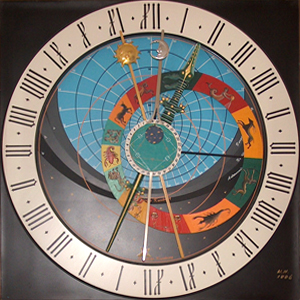
Replica of the astronomical clock of Winterthur
Predecessors in astronomical clocks' technology
At the beginning of the era, Vitruvius, the Roman architect, wrote an extensive story about astronomical clocks. In his astronomical clock, the sun rotated around the zodiac ring in one year. You could also see on which location at the horizon the sun rose and set each day.
At the beginning of the 13 th century, the Arab al-Jazari made a similar clock. In this astronomical clock, outstanding elements have been added, such as dolls that play music on every full hour and bronze falcons that simultaneously drop brass bullets on cymbals.
Europe monks copied this idea, for example, in Saint Albans in England and in Cluny in France . Many middle-aged churches and town halls have been provided with astronomical clocks. From small towns with simple astronomical clocks on the town hall facade to imposing cathedrals with clocks, perfectly unifying all astronomical miracles.
Nowadays, we love to keep up with such perfect technology, even if it were just for its educational value and beauty. .
How it works
- The pointer with the hand indicates local solar time. In one day, it rotates clockwise around the hour ring.
- The pointer with the arrow indicates Greenwich Mean Time. This pointer is adjusted one hour forward during Daylight Saving Time.
- The dial underneath projects the celestial sphere. The blue part represents day, the dark part represents night and the grey color represents dusk. The horizon is shaped by the thick line between the blue and grey.
- The zodiac signs make a complete revolution clockwise in one sidereal day (a normal day minus ca. 4 minutes). The clock shows the location of the different zodiac signs at any time of the day. A sign at 12 p.m. represents the south, a sign at 6 a .m. represents the east, a sign at 6 p.m. represents the west and 12 a .m. represents the north, etc. The imaginary spectator is placed in the centre of the dial.
- Upon the sundial with the hand, which makes one revolution clockwise per day, a sun is placed which makes one revolution anti-clockwise around the zodiac signs per year. In this way, you can always see in which zodiac sign the sun is located.
- The location of the sun in relation to the horizon can also be determined. A sign at 12 p.m. represents the south, a sign at 12 a .m. represents the north etc. Furthermore, the distance between the sun and the horizon indicates how far that sun is over the horizon on that moment of the day in that year. During winter, rotations are small, during summer, rotations are big.
- The moon dial, which also rotates clockwise, carries a moon bol. This bol indicates the moon's lunar phases. The central small dial indicates aging in days.
- The location of the moon on the horizon can be determined by crossing the moon dial with the outer side of the zodiac ring. In this way we can determine the moon's location on the horizon.
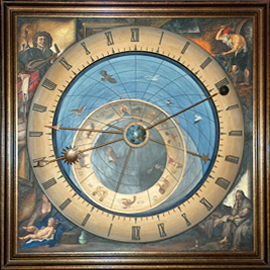
Replica of astronomical clock Royal Eijsbouts Asten
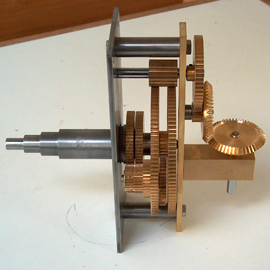
Astronomical gear wheel mechanism
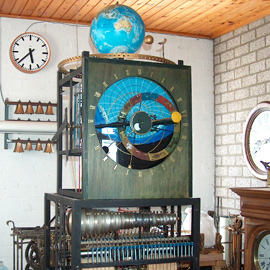
Astronomical clock with carillon
An astronomical clock can be manufactured according to your own ideas or design. You may choose a simple clock or a more complex clock which shows you traditional astronomical time indicators and several planets. Furthermore, it's also possible to place a dragon pointer on the clock which indicates solar or lunar eclipses.
The design of the dial may vary in style and theme, it's up to you.
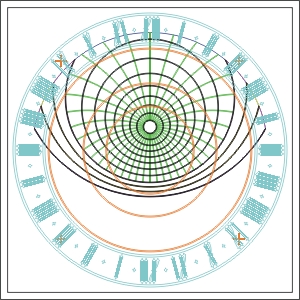
Drawing of an astronomical clock
Click here in order to view the assembly of an astronomical clock.